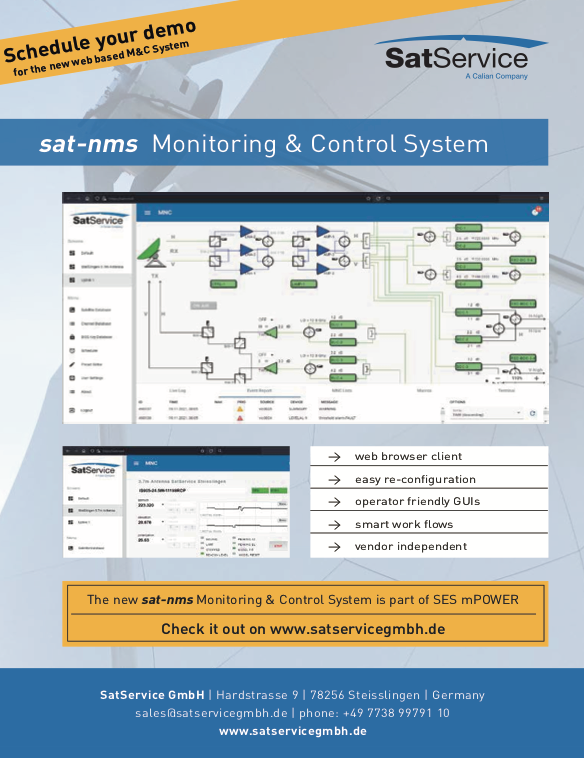New member of Intellian’s family of WGS terminals intro’d
Intellian Technologies Inc. has unveiled their ARC-M4 Block 1 terminal that provides simultaneous X- and military Ka-bands, plus all commercial Ka-, and this Block 1 marks the next extension of Intellian’s Wideband Global SATCOM (WGS) certified products.
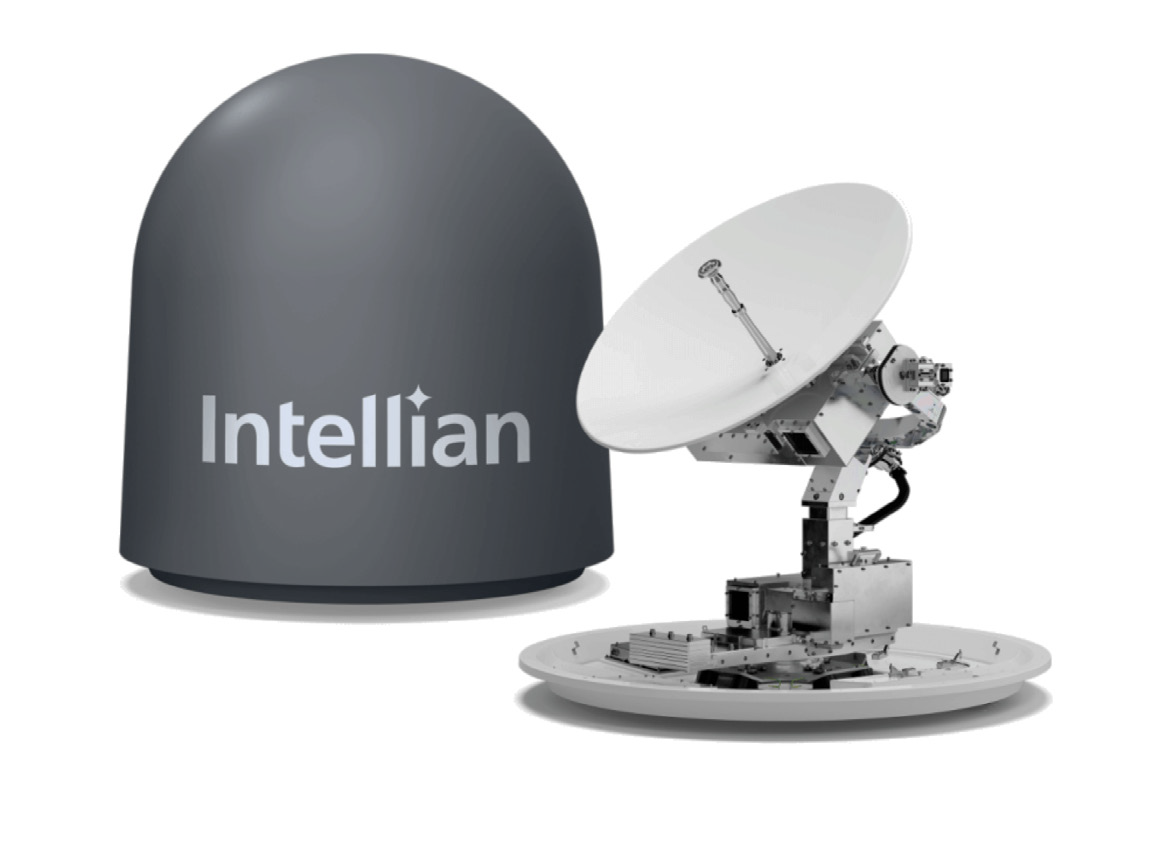
WGS is a high-capacity United States Space Force satellite communication system, developed by the U.S. Department of Defense (DoD) and now includes partnerships with Canada, Australia, The Netherlands, New Zealand, and other member nations. WGS Phase 1 testing has been completed and the terminal is expected to be approved for use on the WGS constellation by Q2 2023.
Intellian’s ARC-M4 Block 1 is a tri-band terminal for X-band, MIL Ka-band and ultra-wide 2.5GHz commercial Ka-band networks. Naval customers can use simultaneous X-band and Ka-band transmit and receive when operating on a WGS satellite, giving unprecedented layers of resilient connectivity and throughput for mission critical operations.
ARC-M4 stands for Advanced Resilient Communications, Multi-mission, multi-role, multi-band, and multi-orbit. It’s designed for operation on LEO, MEO, GEO and HEO satellite orbits.
Built as a follow on terminal to the Intellian’s v130NX PM Dual Ka Block 0 terminal (AN/USC-73), the ARC-M4
Block 1 was developed with a “family of terminals” concept in mind keeping the importance of common CONOPs, common doctrine, ILS, sparing, and preventative maintenance across different antenna types and mission sets. The Block 1 incorporates the Intelligent Mediator 8 enabling users to electronically switch between waveforms, frequency bands, constellations, and orbits.
The ARC-M4 family of terminals are all designed to support full SATCOM shipboard automation through the implementation of Intellian’s ground-breaking Orchestra — the first, Naval policy-based, connectivity management suite.
Orchestra is a 3-tier connectivity policy creation, enforcement, and management system designed for high- intensity mission-critical and highly complex shipboard environments. It alleviates the need for manual intervention to swap frequencies, constellations, waveforms, or orbits in order to maintain connectivity.
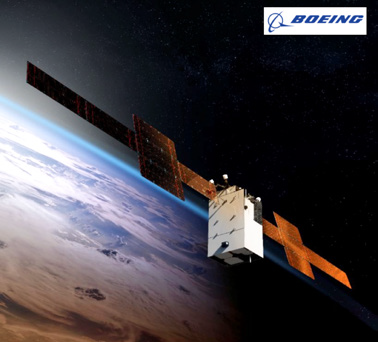
Artistic rendition of WGS
satellite, courtesy of Boeing.
The ARC-M4 family of terminals are commercially off the shelf and available now in volume production. Orders are being accepted for CY 2023 delivery for both v130NX PM Dual Ka Block 0 and ARC-M4 Block 1.
“Intellian collaborated closely with the US Navy to develop the ARC-M4 family of terminals. The Block 1 terminal is the first simultaneous X- and MIL Ka-band terminal to have ever undergone the WGS Certification process. We’re delighted to be unveiling this new technology at Satellite 2023 because we understand how valuable this family of WGS terminals can be for our US Naval customers but also the impact these systems will have on all US-allied Global Navies.” — Sam McKee, General Manager + VP of Sales for Intellian USA
Curtiss-Wright Defense Solutions delivers defense grade security solution
Curtiss-Wright’s Defense Solutions division has shipped their first, integrated, defense grade security solution to a leading defense system integrator for use on a U.S. defense platform.

The fully tested, proven solution includes a suite of IP from best-in-class third-party embedded security developers.
This milestone highlights how Curtiss-Wright’s enhanced Trusted COTS (eTCOTS™) technologies enable customers to more quickly and cost-effectively add state-of-the art security protection to an existing system within a Department of Defense (DoD) end state application.
Curtiss-Wright’s eTCOTS also provides an ideal solution for system designers seeking to rapidly address defense grade security requirements for FMS programs.
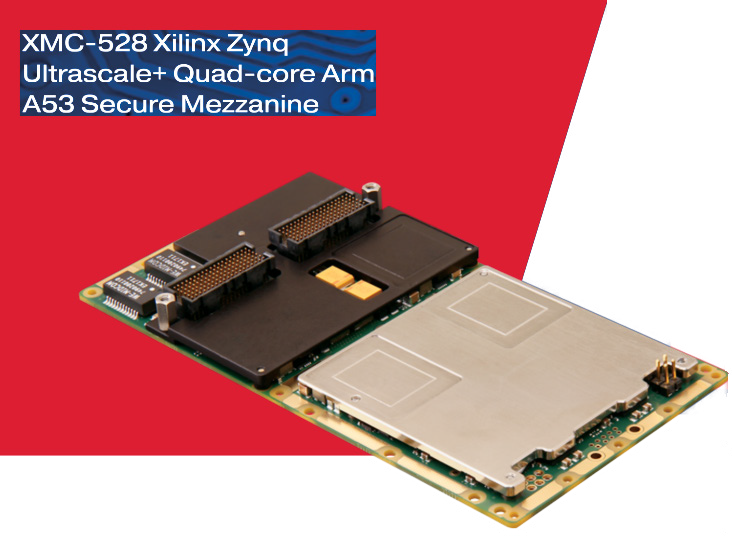
Curtiss-Wright eTCOTS solutions bring advanced defense grade security to MOSA based systems. For example, the XMC-528 Mezzanine Card, an XMC form factor (VITA 42/61) mezzanine module speeds the integration of advanced security IP into OpenVPX™ and legacy VMEbus system solutions using industry- standard interfaces.
The same security IP suite provided by the XMC-528 mezzanine module can also be integrated directly into the on-board security FPGA resident on Curtiss-Wright’s family of security-ready OpenVPX modules – such as the CHAMP-XD3 3U digital signal processor card and select products in Curtiss-Wright’s upcoming high performance Fabric 100™ range of SOSA Technical Standard aligned modules for 3U and 6U embedded computing systems that feature a 100GbE Data Plane and PCIe Gen4 Expansion Plane.
Traditionally, defense-grade security solutions have required custom hardware to protect the system. Curtiss-Wright’s eTCOTS solutions offer an alternative MOSA-based approach that provides customers with secure embedded processing faster and at less cost than the traditional custom approach.
eTCOTS leverages the latest innovations from leading suppliers of defense-grade security to the DoD market and provides the necessary infrastructure on select processor modules to enable the hosting of the IP from these partners and provide users with the exact level of defense-grade security they require. eTCOTS uniquely enables security IP to be added at any phase of the program to support changes in Security Policy.
“We are very proud to announce that we have delivered our first fully integrated defense grade security solution to satisfy critical security requirements for program protection on DoD systems. This important milestone provides a great example of the value of our enhanced Trusted COTS approach, which leverages leading third-party partner IP to bring advanced security capabilities to the warfighter.”
Chris Wiltsey, Senior Vice President and General Manager, Curtiss-Wright Defense Solutions.
Ensign-Bickford Aerospace & Defense demo mission is a success
Ensign-Bickford Aerospace & Defense (EBAD) recently deployed an experimental payload with the company’s Payload Release Ring (PRR) spacecraft separation system.
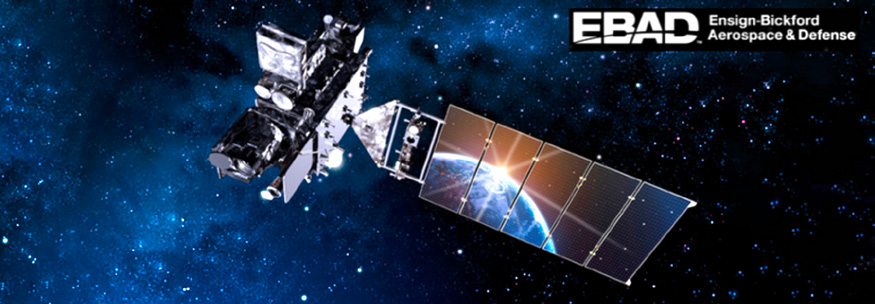
The PRR demonstration mission launched on SpaceX’s Falcon 9 on January 31, 2023, and the PRR successfully deployed the payload from D-Orbit’s ION carrier (artistic rendition, above) on February 8, 2023.
D-Orbit’s ION Satellite Carrier successfully delivered EBAD’s experiment to LEO. The data gathered from this experiment ensures EBAD’s new spacecraft dispensing products carry the same reliability that the industry is accustomed to with its heritage NEA® release mechanism (photo to the left).
The experiment provided valuable data on the performance of the PRR, which is designed to separate satellites from the launch vehicle or orbital transfer vehicle (OTV).
Available in 8-inch, 15-inch, and 24-inch diameters, the PRRs use the NEA® Hold Down & Release Mechanisms (HDRM) and are configured to fasten directly to industry-standard, circular, mounting interfaces, and to satellites up to 800 kg in mass.
Outside of this mission, EBAD has a long history of successful space separation events with its ultra-low shock and high reliability NEA® Hold Down & Release Mechanisms and resettable TiNi™ Mechanisms (photo, middle column, bottom).
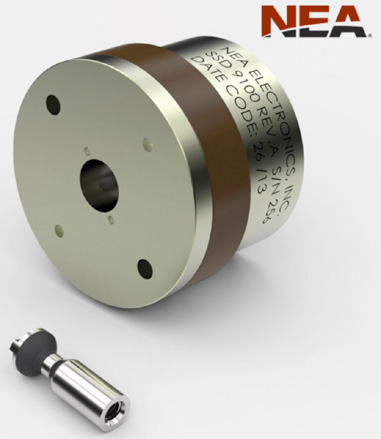
This includes 187 releases on the James Webb Space Telescope, 80 deployments of the OneWeb satellites, and most recently, the release of the O3b mPower satellites in a 4-Point Mount configuration.
This most recent demonstration focused on the PRR 8-inch diameter and EBAD has several other upcoming flight demonstration missions for its 15-inch and 24-inch diameter PRRs, and its integrated 4-Point Mount Separation System, which also use the flight-proven NEA® HDRMs.
“EBAD’s extensive experience in providing reliable, high-quality products to various missions across markets helps them create a product that clients can rely on, no matter the scale of their mission. He said, “EBAD serves both the satellite and launch vehicle markets, giving us a unique understanding of separation and dispensing systems requirements, which reside at the crossroads of both space markets. Our high volume and vertically integrated production capabilities allow us to deliver reliable payload deployment systems with higher value and significantly shorter lead times.” Chad Thompson, president of EBAD Ensign-Bickford Aerospace & Defense has been in business for more than 180 years, supplying world-class initiation and separation system products for space programs for more than 60 years. With facilities in Graham, Kentucky., Moorpark, Californnia, and Simsbury, the company delivers mission-critical solutions for satellites (separation and dispensing), human spacecraft, missiles, and launch vehicles, and has the Space industry’s widest array of flight-proven pyrotechnic and non-pyrotechnic ystem solutions. pyrotechnic and separation system solutions.
Airbus selects Blacktree Technology for UHF MILSATCOM across Australasia
Airbus Defence and Space has selected Blacktree Technology Pty Ltd of Perth, Australia, to provide the ground segment for the Airbus funded, UHF military communications hosted payload on-board a commercial telecommunications satellite manufactured by Airbus.
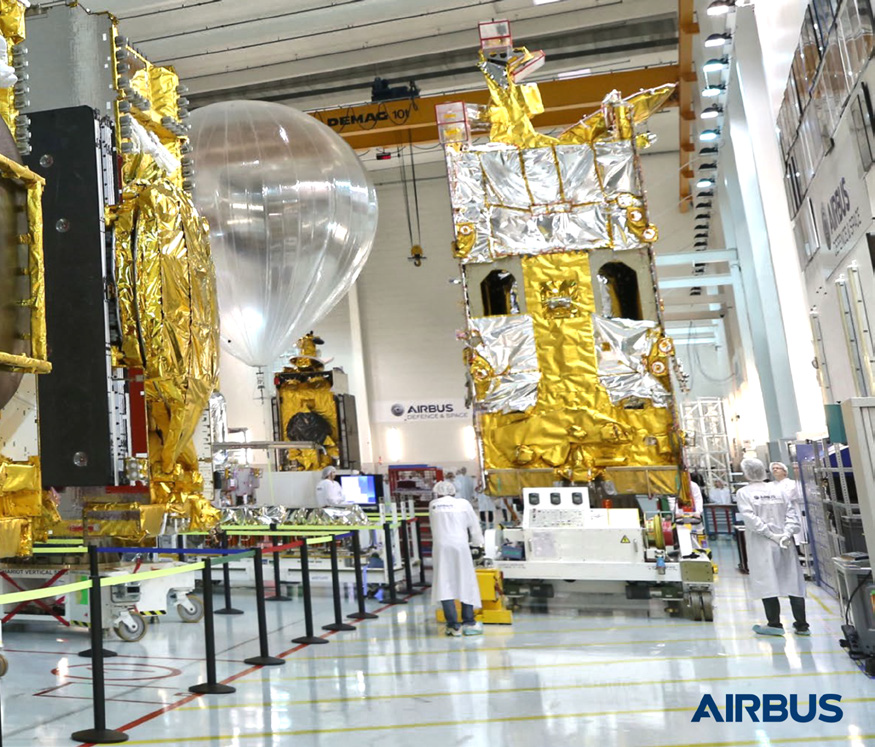
The payload with 18 UHF channels will enable up to 200 simultaneous communications over Europe, the Middle East, Africa, large parts of Asia, as well as the Atlantic Ocean (to eastern Brazil) and the Indian Ocean (to western Australia).
Airbus funded UHF payload will serve allied armed forces that include European and NATO countries Airbus Chief Representative, Australia, New Zealand and the Pacific, Stephen Forshaw, said that the selection reinforced Airbus commitment to integrate Australian technology into the wider Airbus supply chain.
“We’ve been excited to see how much technology is being developed by local companies to support the development of the Space industry in Australia, and that they are winning selection to provide global solutions in Space,” Forshaw said.
Martin Rowse, Airbus Defense and Space Australia director said, “We have selected Blacktree as they offer a proven Australian solution which will support this critical satellite communications capability. The ground segment will be essential in ensuring our customers have access to vital UHF connectivity across the region and beyond.”
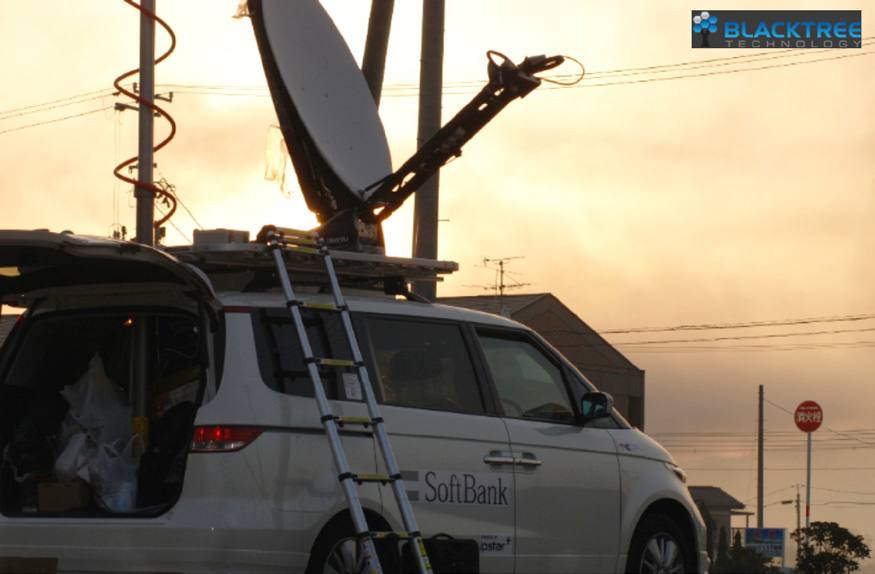
Blacktree Technology’s Managing Director, Joe Nevin, added, “Blacktree Technology is proud to, once again, be selected to support Airbus with UHF ground segment capability. This builds on our strong heritage providing UHF solutions in Australia and across the globe.”
Airbus has been working with Blacktree for more than 15 years under the UK’s SKYNET 5 secure milsatcom program and is partnering with them in Team Maier, as part of the bid to address Australia’s Joint Project (JP) 9102 to provide a complete Sovereign Defense Satellite Communications System.
Team Maier members include technology and encryption specialists Blacktree Technology, Clearbox Systems, Canberra’s specialists Blacktree Technology, Clearbox Systems, Canberra’s Penten, Sydney-based ground-control infrastructure specialist UGL, Surrey Satellite Technology and Indigenous and veteran-owned Willyama.
U.S. Navy receives final GPS-based JPALS unit delivery
The U.S. Navy accepted delivery of the final GPS-based, Joint Precision Approach and Landing Systems (JPALS) unit, marking another on-time or ahead of schedule delivery for increased capability at sea.

JPALS is a ship-relative, GPS-based system that provides aircraft carriers and amphibious assault ships with precision approach and landing capability, surveillance, and over-the- air inertial alignment in all weather and mission environments.
JPALS is currently being deployed on all U.S. Navy aircraft carriers and amphibious assault ships, and is on the United Kingdom Royal Navy’s HMS Queen Elizabeth and the Italian Navy’s ITS Cavour.
Japan became the third foreign military sale customer in December and is scheduled to be deployed on the Japan Maritime Self- Defense Force’s JS Izumo in 2024.
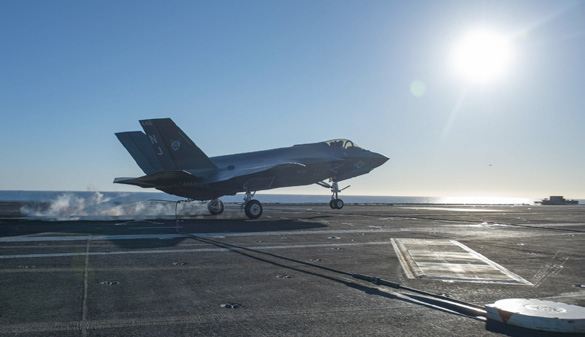
An F-35C Lightning II, from the “Rough Raiders” of Strike
Fighter Squadron (VFA) 125, makes an arrested gear landing
on the flight deck of the aircraft carrier USS Nimitz. Joint Precision
Approach and Landing Systems (JPALS) has been supporting
F-35B deployments on U.S. Navy LH-class amphibious assault
ships since 2016 and F-35C deployments on U.S. Navy aircraft
carriers since 2021.
JPALS has been supporting F-35B deployments on U.S. Navy LH-class amphibious assault ships since 2016 and F-35C deployments on U.S. Navy aircraft carriers since 2021. Initial operational capability was reached in May 2021 with full operational capability scheduled for fiscal year 2026.
“This is a significant milestone for the JPALS team, and highlights the incredible efforts of hundreds of our teammates over the past decade who developed and now have fully delivered these critical systems that our Warfighters and International Partners need. This team overcame many barriers over the past several years, successfully achieving the required outcome to deliver all of the capabilities needed, on time and affordably.” Captain Kevin Watkins, Naval Air Traffic Management Systems (PMA-212) program manager.




